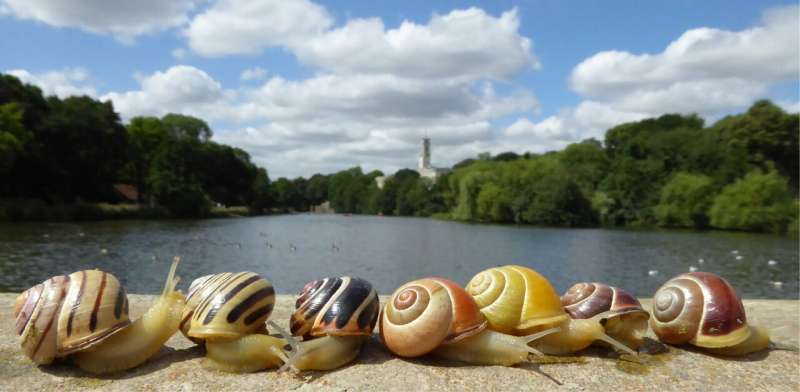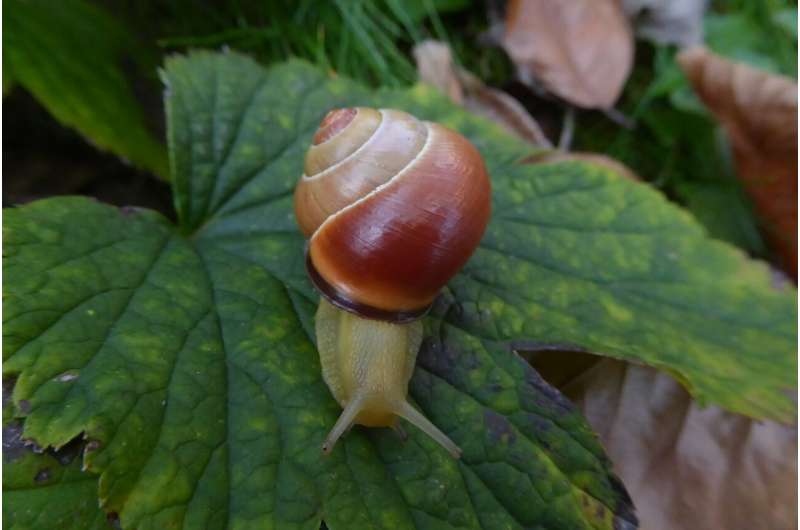Humans struggle to identify snail shell shades, but technology reveals true colors

They're neither white and gold or black and blue. But in an optical puzzle akin to The Dress, colourful snails are causing scientists at the University of Nottingham to turn to technology to definitively decide whether some snails' shells are pink or brown.
The beautifully-hued Cepaea nemoralis - commonly known as grove snails—are found all over Europe in a range of colours, from yellow to pink to brown, with some also having 'humbug' style banding patterns.
But new research published in the academic journal Heredity, shows that differences in the way that the humans see and categorise colour, often makes it tricky to be sure about the colour of snail shells, leading to heated debate among scientists.
The problem of how to classify the colours has important implications for the study of the evolution of snails shell colour in response to factors including warming climate and hiding from predators.
Dr. Angus Davison, Associate Professor and Reader in Evolutionary Genetics in the University's School of Life Sciences, who led the study, said: "The shell patterns and colour are hugely variable—almost like a snail fingerprint. As scientists, to ensure the accuracy of our studies and the subsequent interpretation, it is important that we have a reproducible measure of colour."
"The problem is that there are obvious differences in how humans perceive and categorise their colour, making it very difficult to compare the different types".
Over the past century, the study of animal colour has been critical in helping us to understand the principles of biology, particularly in relation to genetics and evolution. Studies on the distribution and the impact of colour on how predators may identify their prey have shaped our understanding of how natural and sexual selection operate in wild populations and the impact of climate change.
These snails—which are the second most common large snail in UK, and often found in gardens and hedgerows—have also been used in an "Evolution Megalab" experiment in which citizen scientists collect the snails and record the colour. Scientists compare the colour over time—there is a clear indication that the proportions of the different shell types are changing. But these citizen scientists face the same problem in classifying the colours.
Previous studies on grove snails have revealed that they can be sorted into roughly three colour groups—yellow, brown and pink.

It might be sensible to assume that yellow snails are found in dry, arid grasses where they can effectively blend into the background while their brown counterparts may stick to darker woodland environments to camouflage them. The snails uses their colour to evade predators—i.e. as camouflage—and to avoid overheating in open environments.
But surveys of the snails have shown that it's not always that simple—different coloured snails are found across a range of environments.
The colour may also have a role in how predators, particularly birds like song thrushes, choose their prey. Birds develop a preference for the commonest colour of snail over time, and so the rarer types escape predation.
To enable scientists to study the nuances of these issues accurately, they need a way of accurately sorting them into colour groups.
In the Nottingham study, grove snails from Britain and mainland Europe were categorised by Dr. Davison and Ph.D. student Hannah Jackson, by eye.
The same snails were then analysed using a spectrometer, a machine that aims light at the snails, and measures the spectrum of light reflected from the shells.
Using these methods, the scientists were able to cluster the snails into brown, pink and yellow groups and this was compared to how the scientists had categorised the same snails by the naked eye.
The results showed that humans were largely capable of accurately categorising yellow snails but were less successful in identifying which snails were brown or pink. They also disagreed amongst themselves which were pink and which were brown.
The work provides scientists with a baseline measure for further studies into animal colour and the genes which underpin these variations.
Journal information: Heredity
Provided by University of Nottingham




















